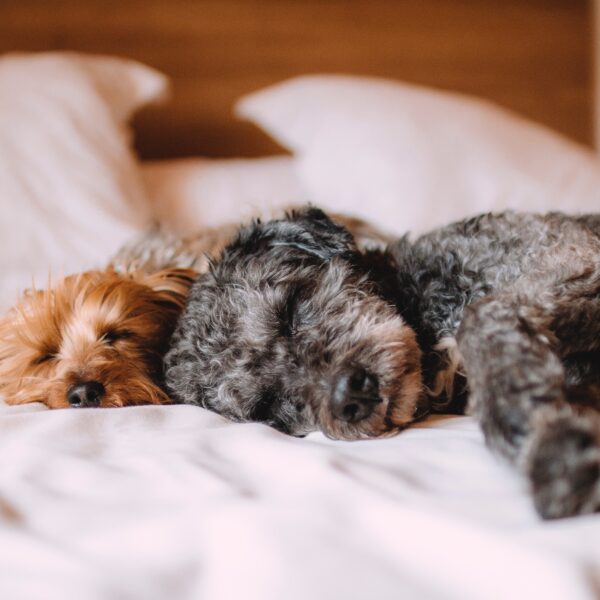If there’s one things dogs absolutely love, it’s a good old walk! Come rain or shine, pups need to be walked every day, with exercise taking up about 30-120 minutes, depending on their age and breed. And, when it comes to dog walking in winter, there are a few top tips to consider to make sure that your dog stays safe and happy. 🐶❄
Winter Dog Walking Top Tips
When it comes to taking your pup out during the colder months, it’s important to think about winter dog care as the chilly weather can be tough on pups – especially their paws!
To make things a bit more straightforward, we’ve created the following list of top tips for dog walking this winter:
- Make sure your pup isn’t too chilly. As the temperatures drop, it’s worth considering that all dogs can feel the cold – even breeds like huskies that are adapted for colder weather! And many pups won’t always make a fuss if they’re feeling chilly and uncomfortable, so this is something worth bearing in mind. Although small and fine-coated breeds tend to need a little more protection from the cold, all dog owners should be on the look out for signs their pup is getting chilly. These signs may include hunching over, trying to seek shelter or huddle up, as well as shivering, becoming more quiet and less active when outside, lifting paws off the ground or trying to end the walk and go back home. If you think your dog may be feeling the cold, it’s worth investing in a nice warm jacket for them. Like for humans, these jackets should be well fitted and well insulated, but it’s also a good idea if they are fairly breathable – so your pup doesn’t overheat when they are running around. And if your dog is a magnet for mud, it’s a good idea to find a jacket that can be easily machine-washed and wiped down.

- Protect their paws. Dog paw care in winter is essential as, when the weather gets really cold, your pup’s feet will be coming into direct contact with frozen puddles and snow, which can be very harsh on their paw pads! Because, of this it’s really important to thoroughly check your dog’s feet after every walk, making sure there is no snow, salt or grit stuck in their fur or in between their toes – as this can be very uncomfortable!
- Recall is essential. If you are planning to let your pup off the lead in the winter, they must be properly trained to come back to you when you call them, as visibility will be much reduced during driving rains, snow and fog – so if your pup runs away you might not be able to find them. It’s also a legal requirement for dogs to be microchipped, so make sure your dog is chipped and your details are up to date to be extra safe. And, if your pup is young, excitable, or doesn’t always respond to their name, it’s safest to keep them on the lead during walks. Also, avoid dog walking near frozen lakes or ponds as even very sensible pups won’t always know to avoid these, which can be extremely dangerous for them!
- Visibility is key. Because winter weather can make it tricky to spot your pup during walks, it’s a good idea to consider investing in a high-visibility jacket, and there are also light-up collars to help you keep an eye on your pup.
- Warm them up. If your dog does get a little cold and wet when out on their walks, make sure your house is warm when you get back, with a cosy bed for your pup to snuggle into – with lots of blankets! And it’s also a good idea to have a towel handy to dry them off, as wet fur can take a long time to dry naturally, making it very tricky for your pup to warm up!
- Keep them active. Some dogs, especially those who are a bit older, may be more reluctant to go out in colder weather. This can sometimes be because of joint problems, such as arthritis, which can flare up during the colder months – so if you think your dog is struggling to walk, or stiffer then normal, it’s best to speak to your vet. Another reason your dog may be reluctant to go out is because they’re too chilly and, if this is the case, it’s best to follow the advice above. However, if your pup simply doesn’t like the cold, consider taking things slowly with them, to help get them used to the temperature difference. You can take them for slightly shorter walks more regularly if they’re really not keen on the cold! Another tip is to keep them as active as possible indoors. You could encourage them to be up and about playing with their toys and, if you have enough space, you can even play fetch with them!

Adjust their diet
Some pups will be a bit less active in the colder months. This is normally fine, so long as they are still managing to exercise enough every day – even if it’s just short walks. However, if your dog’s daily exercise is reduced, it’s important to also reduce the amount of food they consume, as you don’t want them to become overweight. If you’re unsure whether or not your pup is the right weight, or don’t know how to reduce their food safely, it’s best to speak to a veterinary professional for further advice.
That concludes our top tips for walking dogs in the winter! And, if you would like more general advice on dog walking, check out our article “How far to walk your dog“.


